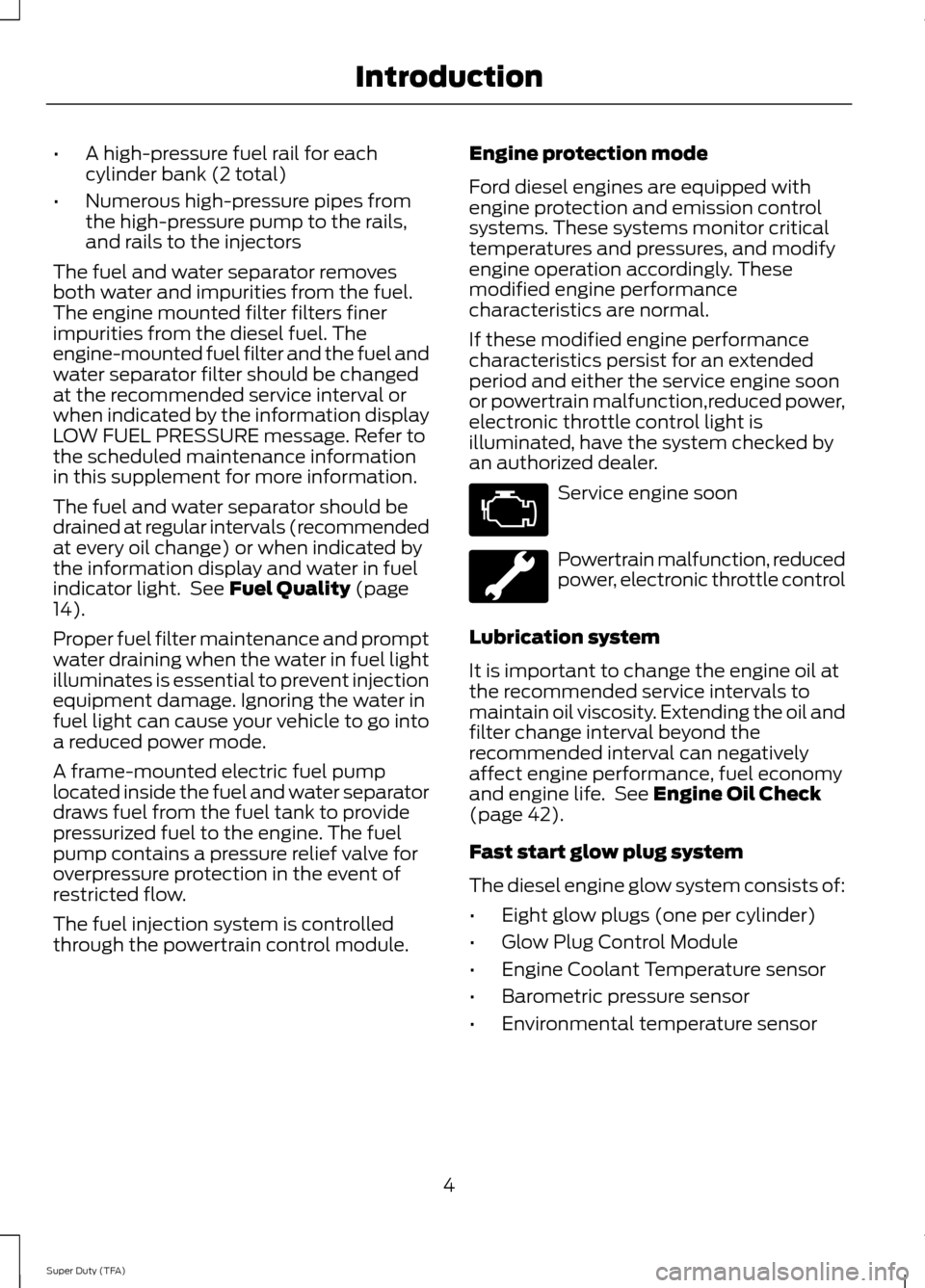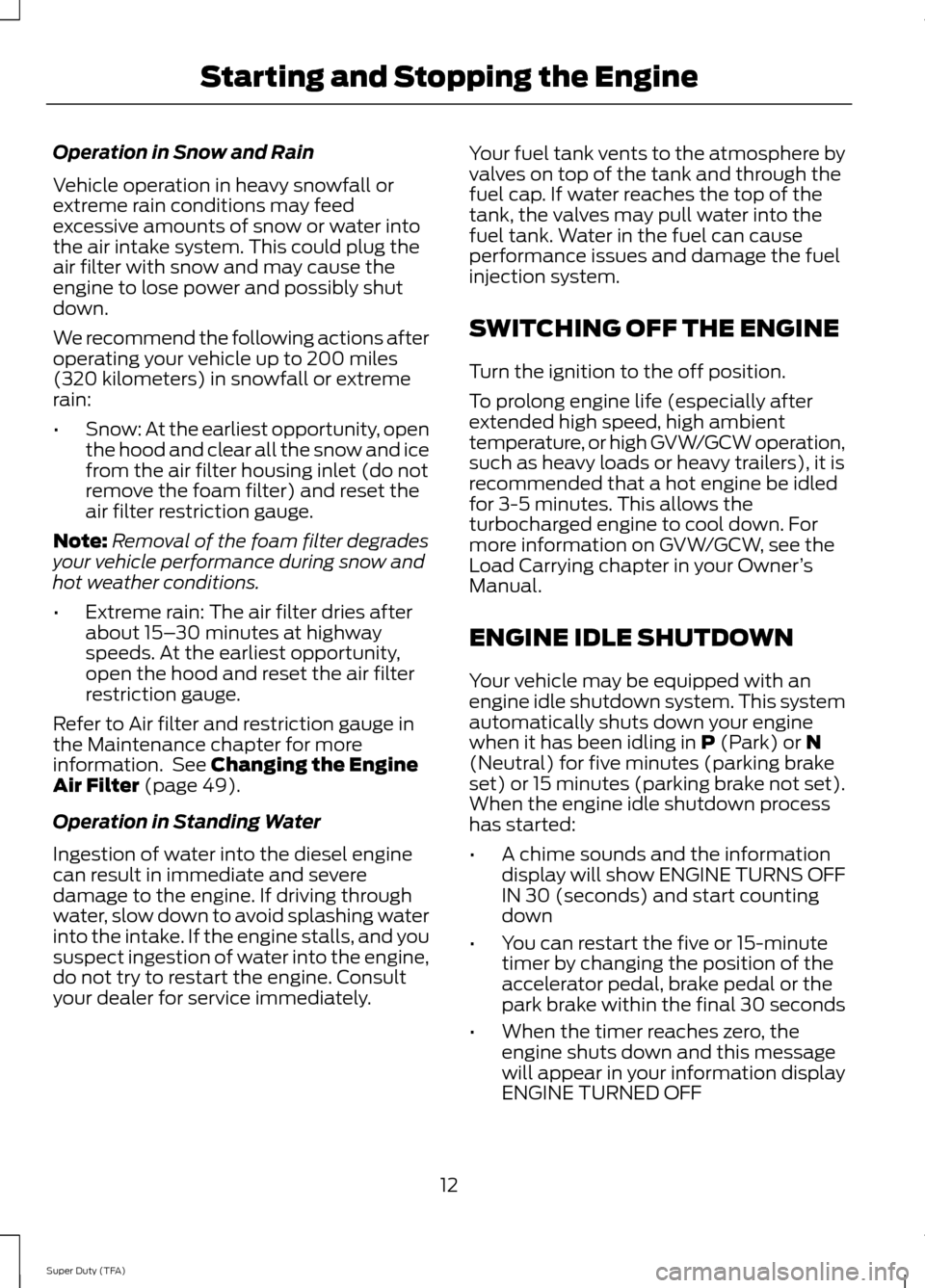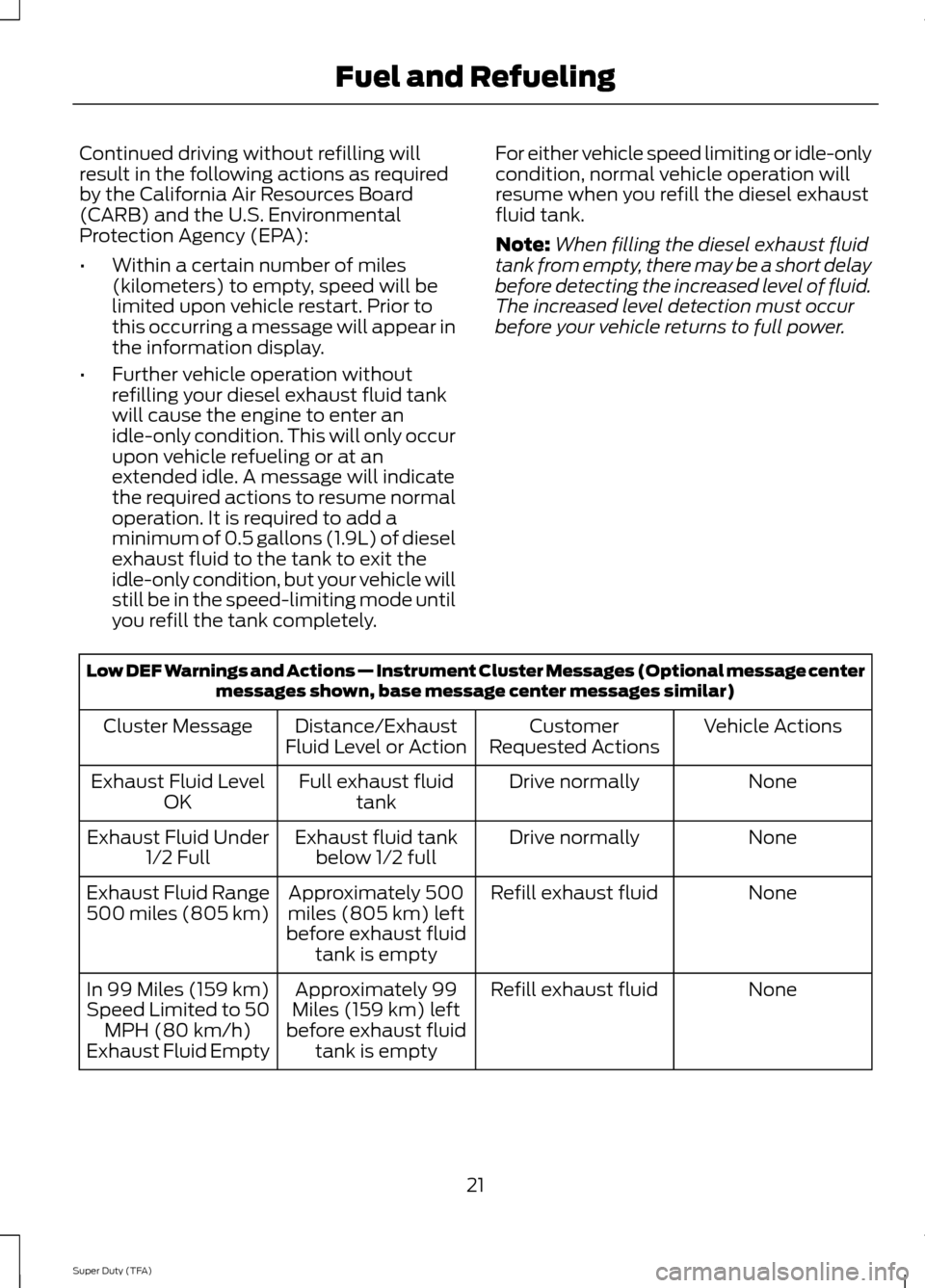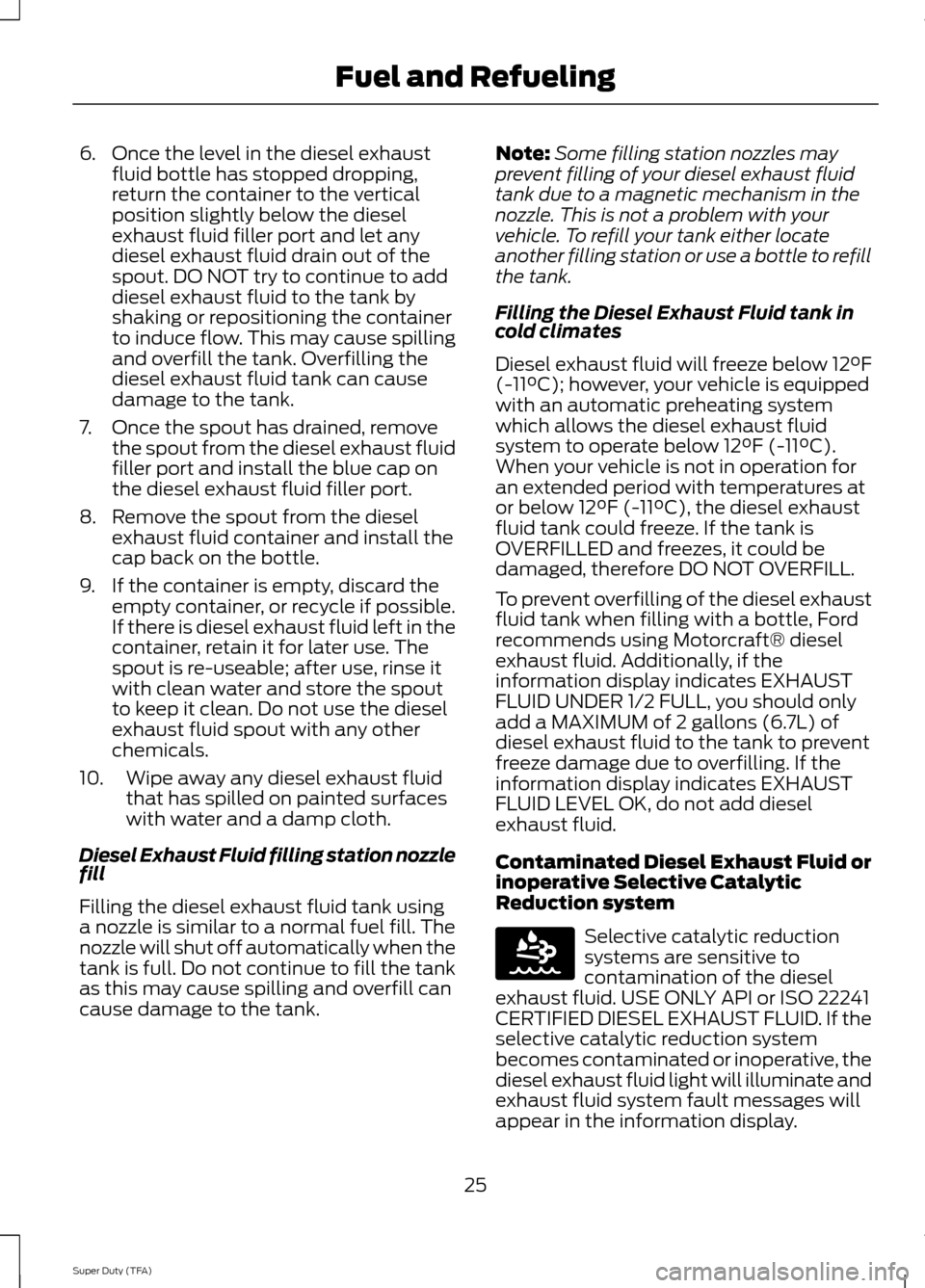2014 FORD SUPER DUTY display
[x] Cancel search: displayPage 7 of 82

•
A high-pressure fuel rail for each
cylinder bank (2 total)
• Numerous high-pressure pipes from
the high-pressure pump to the rails,
and rails to the injectors
The fuel and water separator removes
both water and impurities from the fuel.
The engine mounted filter filters finer
impurities from the diesel fuel. The
engine-mounted fuel filter and the fuel and
water separator filter should be changed
at the recommended service interval or
when indicated by the information display
LOW FUEL PRESSURE message. Refer to
the scheduled maintenance information
in this supplement for more information.
The fuel and water separator should be
drained at regular intervals (recommended
at every oil change) or when indicated by
the information display and water in fuel
indicator light. See Fuel Quality (page
14).
Proper fuel filter maintenance and prompt
water draining when the water in fuel light
illuminates is essential to prevent injection
equipment damage. Ignoring the water in
fuel light can cause your vehicle to go into
a reduced power mode.
A frame-mounted electric fuel pump
located inside the fuel and water separator
draws fuel from the fuel tank to provide
pressurized fuel to the engine. The fuel
pump contains a pressure relief valve for
overpressure protection in the event of
restricted flow.
The fuel injection system is controlled
through the powertrain control module. Engine protection mode
Ford diesel engines are equipped with
engine protection and emission control
systems. These systems monitor critical
temperatures and pressures, and modify
engine operation accordingly. These
modified engine performance
characteristics are normal.
If these modified engine performance
characteristics persist for an extended
period and either the service engine soon
or powertrain malfunction,reduced power,
electronic throttle control light is
illuminated, have the system checked by
an authorized dealer.
Service engine soon
Powertrain malfunction, reduced
power, electronic throttle control
Lubrication system
It is important to change the engine oil at
the recommended service intervals to
maintain oil viscosity. Extending the oil and
filter change interval beyond the
recommended interval can negatively
affect engine performance, fuel economy
and engine life. See
Engine Oil Check
(page 42).
Fast start glow plug system
The diesel engine glow system consists of:
• Eight glow plugs (one per cylinder)
• Glow Plug Control Module
• Engine Coolant Temperature sensor
• Barometric pressure sensor
• Environmental temperature sensor
4
Super Duty (TFA) Introduction
Page 10 of 82

GAUGES
Cluster shown in standard measure. Metric
similar.Engine boost gauge
A
Engine Boost Gauge
Indicates the amount of manifold air
pressure in the engine
WARNING LAMPS AND
INDICATORS
The following warning lamps and
indicators will alert you to a vehicle
condition that may become serious. Some
lamps will illuminate when you start your
vehicle to make sure they work. If any
lamps remain on after starting your vehicle,
refer to the respective system warning
lamp for further information. Note:
Some warning indicators appear in
the information display and function the
same as a warning lamp but do not display
when you start your vehicle.
Diesel Exhaust Fluid With the key in the on position,
this light illuminates if the
exhaust fluid is contaminated or
low. See Selective Catalytic Reduction
System (page 20).
7
Super Duty (TFA) Instrument ClusterE163169 E163176
Page 12 of 82

STARTING A DIESEL ENGINE
Read all starting instructions carefully
before you start your vehicle.
For temperatures below 32°F (0°C), the
use of the correct grade engine oil is
essential for proper operation. Refer to
Engine oil specifications for more
information. See Technical
Specifications (page 56).
Your vehicle may be equipped with a cold
weather starting strategy that prevents
severe engine damage by assisting in
engine lubrication warm-up. In extremely
cold ambient temperatures, this strategy
activates and prevents the accelerator
pedal from being used for 30 seconds after
starting your vehicle. A message will
appear in the information display as your
vehicle warms up. By not allowing the
accelerator pedal to be used, the engine
oil is allowed to properly lubricate the
bearings preventing engine damage due
to lack of proper lubrication. After the 30
second warm-up period, the accelerator
pedal will be operational again and a
message will appear informing you the
vehicle is ok to drive.
When starting the engine in extremely cold
temperatures (-15°F [– 26°C]), it is
recommended to allow the engine to idle
for several minutes before driving the
vehicle.
Make sure the gearshift lever is in P (Park)
and the parking brake is fully set before
you turn the key. Do not press the
accelerator during starting.
Cold Weather Starting WARNINGS
Do not use starting fluid, such as
ether, in the air intake system (see
air filter decal). Such fluid could
cause immediate explosive damage to the
engine and possible personal injury WARNINGS
Do not add gasoline, gasohol, alcohol
or Kerosene to diesel fuel. This
practice creates a serious fire hazard
and causes engine performance problems. It is recommended that the engine block
heater be used for starting when the
temperature is -10°F (-23°C) or colder.
Refer to Engine block heater later in this
chapter for more information.
When operating in cold weather,
Motorcraft® cetane improvers or
non-alcohol-based cetane improvers from
a reputable manufacturer may be used as
needed.
Do not crank the engine for more than 10
seconds as starter damage may occur. If
the engine fails to start, turn the key to
position 3 (off) and wait 30 seconds
before trying again.
1. Turn the key to on without turning the
key to start. Do not start the engine
until the glow-plug indicator turns off.
2. When the glow plug pre-heat indicator
turns off, turn the key to start and
release the key as soon as the engine
starts. After starting the engine, the
glow plugs may remain on for a period.
If you do not start the engine before
the glow plug activation time ends, you
will need to reset the glow plugs by
turning the key to off.
3. After the engine starts, allow it to idle for about 15 seconds. This is to protect
the engine. Do not increase engine
speed until the oil pressure gauge
indicates normal pressure.
9
Super Duty (TFA) Starting and Stopping the Engine
Page 15 of 82

Operation in Snow and Rain
Vehicle operation in heavy snowfall or
extreme rain conditions may feed
excessive amounts of snow or water into
the air intake system. This could plug the
air filter with snow and may cause the
engine to lose power and possibly shut
down.
We recommend the following actions after
operating your vehicle up to 200 miles
(320 kilometers) in snowfall or extreme
rain:
•
Snow: At the earliest opportunity, open
the hood and clear all the snow and ice
from the air filter housing inlet (do not
remove the foam filter) and reset the
air filter restriction gauge.
Note: Removal of the foam filter degrades
your vehicle performance during snow and
hot weather conditions.
• Extreme rain: The air filter dries after
about 15– 30 minutes at highway
speeds. At the earliest opportunity,
open the hood and reset the air filter
restriction gauge.
Refer to Air filter and restriction gauge in
the Maintenance chapter for more
information. See Changing the Engine
Air Filter (page 49).
Operation in Standing Water
Ingestion of water into the diesel engine
can result in immediate and severe
damage to the engine. If driving through
water, slow down to avoid splashing water
into the intake. If the engine stalls, and you
suspect ingestion of water into the engine,
do not try to restart the engine. Consult
your dealer for service immediately. Your fuel tank vents to the atmosphere by
valves on top of the tank and through the
fuel cap. If water reaches the top of the
tank, the valves may pull water into the
fuel tank. Water in the fuel can cause
performance issues and damage the fuel
injection system.
SWITCHING OFF THE ENGINE
Turn the ignition to the off position.
To prolong engine life (especially after
extended high speed, high ambient
temperature, or high GVW/GCW operation,
such as heavy loads or heavy trailers), it is
recommended that a hot engine be idled
for 3-5 minutes. This allows the
turbocharged engine to cool down. For
more information on GVW/GCW, see the
Load Carrying chapter in your Owner
’s
Manual.
ENGINE IDLE SHUTDOWN
Your vehicle may be equipped with an
engine idle shutdown system. This system
automatically shuts down your engine
when it has been idling in
P (Park) or N
(Neutral) for five minutes (parking brake
set) or 15 minutes (parking brake not set).
When the engine idle shutdown process
has started:
• A chime sounds and the information
display will show ENGINE TURNS OFF
IN 30 (seconds) and start counting
down
• You can restart the five or 15-minute
timer by changing the position of the
accelerator pedal, brake pedal or the
park brake within the final 30 seconds
• When the timer reaches zero, the
engine shuts down and this message
will appear in your information display
ENGINE TURNED OFF
12
Super Duty (TFA) Starting and Stopping the Engine
Page 20 of 82

3.
Rotate the drain counterclockwise until
the O-ring is visible. Allow the diesel
fuel conditioner module to drain for
approximately 25 seconds or until
clean fuel is observed. Rotate the drain
clockwise to tighten it. If no liquid
drains, there may be a clog in the drain.
Have the conditioner module serviced
by an authorized dealer.
4. Make sure that you fully tighten the drain valve and then remove the
container from under your vehicle.
5. Restart the engine. If the WATER IN FUEL DRAIN FILTER or WATER IN FUEL
DRAIN FILTER SEE MANUAL message
and light continues to illuminate, have
the fuel system checked and repaired.
Low Fuel Pressure
The engine is equipped with a low fuel
pressure detection system. Here are some
possible causes if a low fuel pressure
message appears in the information
display:
• Cold start or during cold operation
(below 32°F (0°C): If the low fuel
pressure message appears during a
cold start or up to 10 minutes after the
initial cold start, monitor the
information display. If the low fuel
pressure message disappears and does
not re-appear after the engine has fully
warmed up, waxed or gelled fuel is what most likely caused the message.
Do not use alcohol based additives to
correct fuel gelling. This may result in
damage to the fuel injectors and
systems. Use an anti-gel additive. See
Technical Specifications (page 56).
Note: Your customer warranty may be void
from using additives that do not meet or
exceed Ford specifications. If the low fuel
pressure message persistently appears after
re-fueling during the cold start and cold
operation conditions defined previously and
then disappear when the engine has fully
warmed up, consider different fuel sources.
• Low fuel operation: If the low fuel
pressure message appears when your
vehicle is warm and during low fuel
tank level operation (near empty),
refuel your vehicle. If the message
reappears after fueling, see below. If
the message does not come back, the
low fuel pressure condition was due to
low fuel levels in the fuel tank.
• Normal operation: If the low fuel
pressure message appears during
normal operation when the engine is
fully warm, and fuel level is not low,
you must change the fuel filters
regardless of the maintenance
schedule interval.
• If replacement of the fuel filter does
not remedy the low fuel pressure
message during normal operation as
defined above, take the vehicle to an
authorized dealer.
Changing the Engine-Mounted and
Diesel Fuel Conditioner Module Fuel
Filters
Your vehicle is equipped with two fuel
filters. The first filter mounts on top of the
engine on the driver ’s side. The second
filter, inside the diesel fuel conditioner
module, is mounted on the frame rail under
the driver ’s side floorboard near the
transmission. You should replace both
17
Super Duty (TFA) Fuel and RefuelingE163360
Page 23 of 82

SELECTIVE CATALYTIC
REDUCTION SYSTEM
Your vehicle is equipped with a selective
catalytic reduction system to help reduce
emission levels of oxides of nitrogen from
the exhaust of the diesel engine. The
system automatically injects diesel
exhaust fluid into the exhaust system to
enable proper selective catalytic reduction
function.
Importance of maintaining the
Diesel Exhaust Fluid level
In order for the selective catalytic reduction
system to operate properly, the diesel
exhaust fluid level must be maintained.
Generally, the diesel exhaust fluid tank
should be filled during the oil change
service interval. See General
Maintenance Information (page 58).
However, certain conditions or driving
styles, such as trailer towing or fast rates
of acceleration, will require the refilling of
the diesel exhaust fluid tank more often.
The engine control unit will monitor the
amount of fluid available in the diesel
exhaust fluid tank. Running a system check
in the message center will indicate whether
the diesel exhaust fluid level is ok or if it is
less than 1/2 full. A message will display in
the message center when the diesel
exhaust fluid level is low and needs to be
refilled. When you see this message, you
should refill your tank. See the Information
displays chapter of your Owner ’s Manual
for information display functions. For
instructions on refilling your diesel exhaust
fluid tank, see filling the diesel exhaust
fluid tank in this supplement. Diesel Exhaust Fluid warning
messages and vehicle operations WARNINGS
Diesel exhaust fluid must be refilled
when low or replaced when
contaminated or the vehicle speed
will be speed limited to 50 mph (80 km/h).
In these conditions, drive with caution and
refill diesel exhaust fluid immediately. If
the diesel exhaust fluid becomes empty
or contaminated and fluid is not replaced,
your vehicle will become limited to idle
speed only once stopped. In these
conditions, be cautious where you stop
your vehicle because you may not be able
to drive long distances and will not be able
to maintain highway speeds until diesel
exhaust fluid is refilled or replaced. Tampering or disabling your vehicle
’s
exhaust aftertreatment system will
result in severe vehicle performance
limitation including eventual speed limiting
to 5 mph. Your vehicle
’s information display will
display a series of messages regarding the
amount of diesel exhaust fluid available.
A systems check will display messages
indicating the amount of diesel exhaust
fluid available (OK or under 1⁄2 full) or will
produce a warning message that displays
the mileage (kilometers) remaining as the
fluid in the diesel exhaust fluid tank nears
empty. For more information on warning
messages, see the Information Displays
chapter of your Owner ’s Manual. As the diesel exhaust fluid level
nears empty, the diesel exhaust
fluid warning symbol will be
displayed and chimes will sound with the
messages starting at 500 miles (805 km)
remaining before diesel exhaust fluid is
depleted. The warning symbol and
messages will continue until you refill the
diesel exhaust fluid tank.
20
Super Duty (TFA) Fuel and RefuelingE163176
Page 24 of 82

Continued driving without refilling will
result in the following actions as required
by the California Air Resources Board
(CARB) and the U.S. Environmental
Protection Agency (EPA):
•
Within a certain number of miles
(kilometers) to empty, speed will be
limited upon vehicle restart. Prior to
this occurring a message will appear in
the information display.
• Further vehicle operation without
refilling your diesel exhaust fluid tank
will cause the engine to enter an
idle-only condition. This will only occur
upon vehicle refueling or at an
extended idle. A message will indicate
the required actions to resume normal
operation. It is required to add a
minimum of 0.5 gallons (1.9L) of diesel
exhaust fluid to the tank to exit the
idle-only condition, but your vehicle will
still be in the speed-limiting mode until
you refill the tank completely. For either vehicle speed limiting or idle-only
condition, normal vehicle operation will
resume when you refill the diesel exhaust
fluid tank.
Note:
When filling the diesel exhaust fluid
tank from empty, there may be a short delay
before detecting the increased level of fluid.
The increased level detection must occur
before your vehicle returns to full power. Low DEF Warnings and Actions — Instrument Cluster Messages (Optional message center
messages shown, base message center messages similar)
Vehicle Actions
Customer
Requested Actions
Distance/Exhaust
Fluid Level or Action
Cluster Message
None
Drive normally
Full exhaust fluid
tank
Exhaust Fluid Level
OK
None
Drive normally
Exhaust fluid tank
below 1⁄2 full
Exhaust Fluid Under
1⁄2 Full
None
Refill exhaust fluid
Approximately 500
miles (805 km) left
before exhaust fluid tank is empty
Exhaust Fluid Range
500 miles (805 km)
None
Refill exhaust fluid
Approximately 99
Miles (159 km) left
before exhaust fluid tank is empty
In 99 Miles (159 km)
Speed Limited to 50
MPH (80 km/h)
Exhaust Fluid Empty
21
Super Duty (TFA) Fuel and Refueling
Page 28 of 82

6. Once the level in the diesel exhaust
fluid bottle has stopped dropping,
return the container to the vertical
position slightly below the diesel
exhaust fluid filler port and let any
diesel exhaust fluid drain out of the
spout. DO NOT try to continue to add
diesel exhaust fluid to the tank by
shaking or repositioning the container
to induce flow. This may cause spilling
and overfill the tank. Overfilling the
diesel exhaust fluid tank can cause
damage to the tank.
7. Once the spout has drained, remove the spout from the diesel exhaust fluid
filler port and install the blue cap on
the diesel exhaust fluid filler port.
8. Remove the spout from the diesel exhaust fluid container and install the
cap back on the bottle.
9. If the container is empty, discard the empty container, or recycle if possible.
If there is diesel exhaust fluid left in the
container, retain it for later use. The
spout is re-useable; after use, rinse it
with clean water and store the spout
to keep it clean. Do not use the diesel
exhaust fluid spout with any other
chemicals.
10. Wipe away any diesel exhaust fluid that has spilled on painted surfaces
with water and a damp cloth.
Diesel Exhaust Fluid filling station nozzle
fill
Filling the diesel exhaust fluid tank using
a nozzle is similar to a normal fuel fill. The
nozzle will shut off automatically when the
tank is full. Do not continue to fill the tank
as this may cause spilling and overfill can
cause damage to the tank. Note:
Some filling station nozzles may
prevent filling of your diesel exhaust fluid
tank due to a magnetic mechanism in the
nozzle. This is not a problem with your
vehicle. To refill your tank either locate
another filling station or use a bottle to refill
the tank.
Filling the Diesel Exhaust Fluid tank in
cold climates
Diesel exhaust fluid will freeze below 12°F
(-11°C); however, your vehicle is equipped
with an automatic preheating system
which allows the diesel exhaust fluid
system to operate below 12°F (-11°C).
When your vehicle is not in operation for
an extended period with temperatures at
or below 12°F (-11°C), the diesel exhaust
fluid tank could freeze. If the tank is
OVERFILLED and freezes, it could be
damaged, therefore DO NOT OVERFILL.
To prevent overfilling of the diesel exhaust
fluid tank when filling with a bottle, Ford
recommends using Motorcraft® diesel
exhaust fluid. Additionally, if the
information display indicates EXHAUST
FLUID UNDER 1/2 FULL, you should only
add a MAXIMUM of 2 gallons (6.7L) of
diesel exhaust fluid to the tank to prevent
freeze damage due to overfilling. If the
information display indicates EXHAUST
FLUID LEVEL OK, do not add diesel
exhaust fluid.
Contaminated Diesel Exhaust Fluid or
inoperative Selective Catalytic
Reduction system Selective catalytic reduction
systems are sensitive to
contamination of the diesel
exhaust fluid. USE ONLY API or ISO 22241
CERTIFIED DIESEL EXHAUST FLUID. If the
selective catalytic reduction system
becomes contaminated or inoperative, the
diesel exhaust fluid light will illuminate and
exhaust fluid system fault messages will
appear in the information display.
25
Super Duty (TFA) Fuel and RefuelingE163176